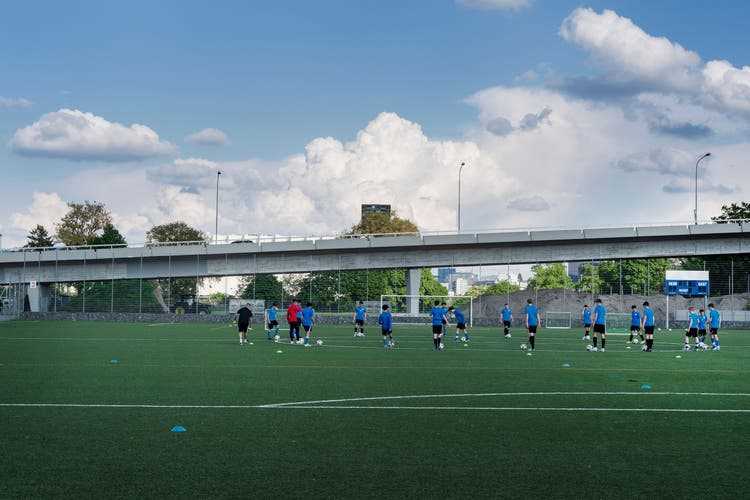A foray from the main station to the outskirts.
Some say that Zurich is most beautiful by the lake. Others claim that the soul of the city can be found in the Limmat on a lazy sunny day. The blue trams, the historic center, the rich Bahnhofstrasse, the hip Idaplatz: What hasn’t already been declared to be the epitome of Zurich.
The real heart of the city is somewhere else.
It lies in the middle of a vast uninhabited area that extends to the outskirts of the city. We all move on it almost every day. It brings us to where we want to be – and to the city, the people and the goods that make Zurich a metropolis.
The heart of Zurich is – whether we like it or not – the gigantic track field that branches out from the main station like a network of arteries throughout the city.
And if you’re not sitting in a train, you have to use one of five bridges between the main station and the city limits to cross this gigantic track area. (In a few years, as the city recently announced, there will be six thanks to a new bicycle bridge at the Letten Viaduct.)
These bridges all fulfill the same function and yet are different. They each show a different side of this city, whose two halves to the left and right of the tracks they connect.
Sometimes the beautiful comes before the useful in Zurich.
At the Sechseläutenplatz, for example, which offers a spectacular expanse but hardly any shade in summer. Or in the Münsterhof, where the seating was long forgotten due to the sheer redesign.
Or right here, a few hundred meters from the main train station, where a curved little concrete work of art pretends to be a functional bridge – when it is actually a promenade for train lovers.
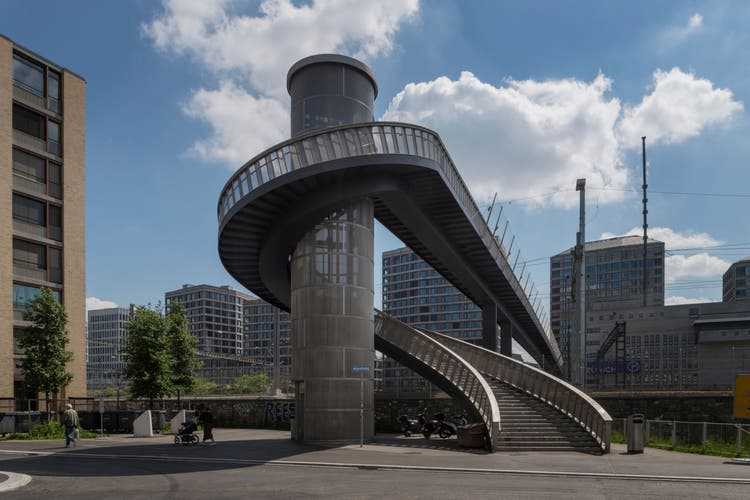
Actually, a bike ramp should have led to the Negrellisteg. But that was too expensive for the city.
A bike path across the tracks would have been needed here so that you don’t have to curve through the station or go to Langstrasse. That was exactly what was originally planned. For cost reasons, however, only a pedestrian bridge was built for all those who are too comfortable for the small detour through the Shop Ville underpass.
Further back in Altstetten there is no way over the tracks between the Duttweiler and Europa bridges at 1500 meters. Building the beautiful little bridge 400 meters from HB was nevertheless a priority. It was only opened last year, making it the youngest of the bridges over the Zurich tracks.
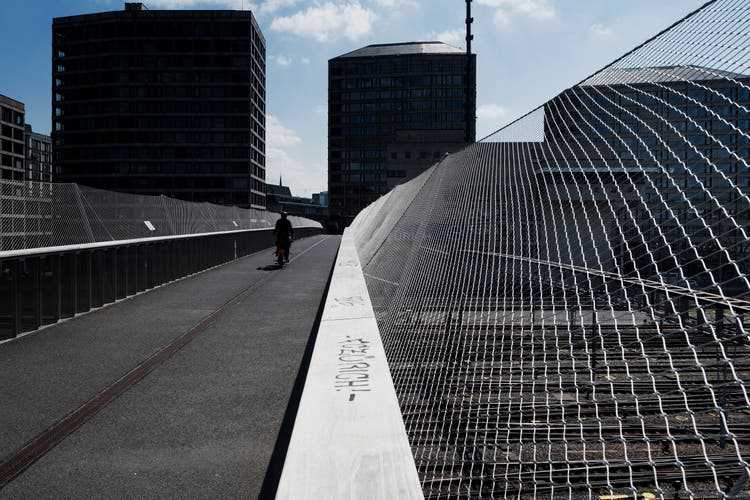
The Negrellisteg connects two districts that promise more than they offer.
The Negrellisteg connects the concrete and glass desert of the Europaallee with the similarly forbidding gray blocks of the customs house superstructure. The business people here and the members of the cooperative there can get closer to each other. And with it two newly built quarters on the tracks, both of which promise more liveliness than they offer.
Nevertheless, the view from the Negrellisteg out of town over trains, tracks and other bridges is beautiful. With a can of beer in hand, this is a wonderful place to celebrate the victory of the beautiful over the useful.
Sometimes everything is so perfectly planned and orchestrated in Zurich. It’s just that humans don’t quite fit in.
For example on the Hardbrücke. There are trams and buses on the move, cars and cyclists, pedestrians and e-scooters. And there is a place for everyone, a marked lane, a designated area where they have to drive or wait, walk or stop.
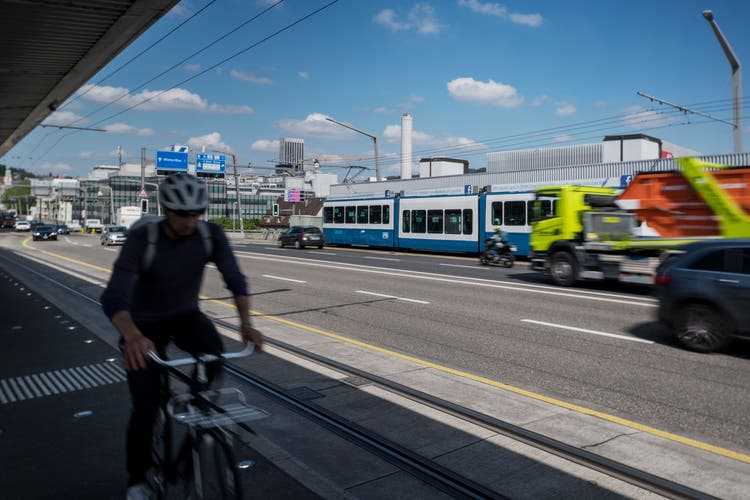
Every means of transport has its place on the Hardbrücke. But chaos still exists.
Floor lights flash in a mysterious language to indicate whether bicycles are passing or commuters are allowed to board the bus. A system of light signals and driveways brings trams and cars past each other. Countless pictograms guide train passengers from the bridge over various stairs to the correct platform in the station below.
Everything would be so wonderfully thought out if it weren’t for the human being.
The person who rushes down the wrong stairs looking at his cell phone. Standing in the way of tram number 8 in his off-roader. Who plows through waiting crowds of pedestrians with his racing bike despite the clear blinking signal. And who enjoys the view of the track field instead of paying attention to the lights and traffic lights.
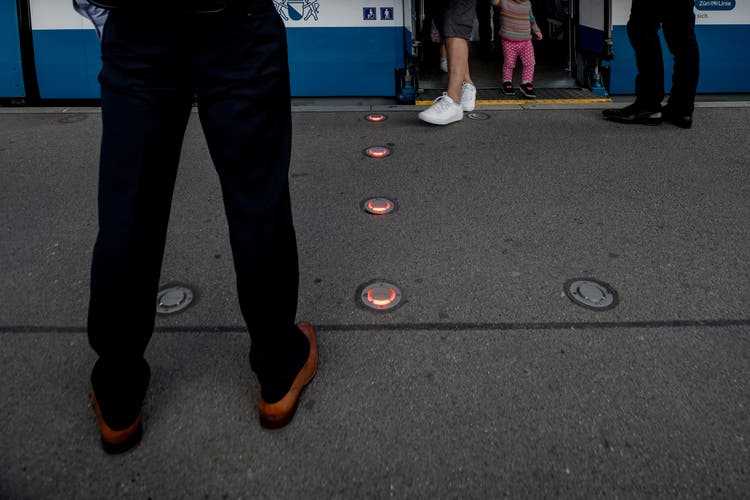
A sophisticated flashing concept shows whether bicycles or pedestrians are allowed to pass on the Hardbrücke.
Being on the Hardbrücke means admiring the perfect organization – and somehow feeling out of place in it. It is the Zurich native’s slight impotence in the face of an ideally designed city.
Only a look at history reveals that even in Zurich not all plans work out: When it opened in 1972, the Hardbrücke was only a temporary solution thought.
You go on this bridge because you have to.
Between Zurich-West and Aussersihl there is no crossing over a distance of two kilometers apart from this one. Trams and buses give it a wide berth. And even as a pedestrian or cyclist you have to overcome a number of red lights to make it up here.
But then, when you get to the top, you suddenly stop – because you want to.
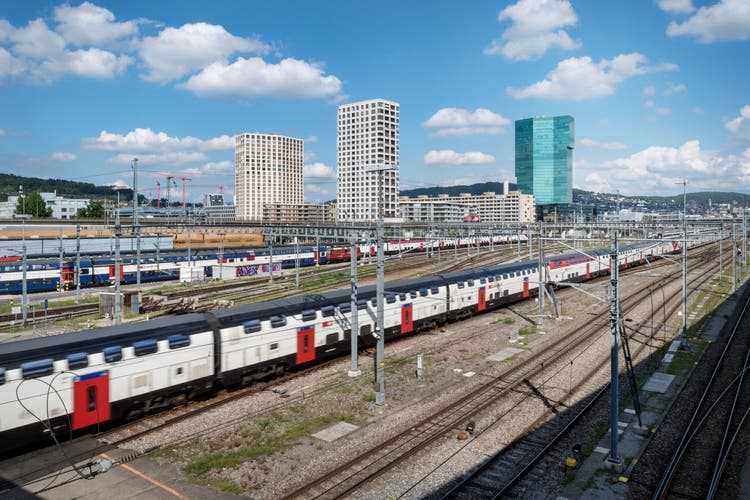
Only those who have to go up here. But you stop at the top of the Duttweiler Bridge because you want to.
On the right the track field in its entire width, on the left the Zurich skyline and around the bridge the meandering trains. Four viaducts pass under, over, to the right and to the left.
On the Duttweilerbrücke (built without much effort in 1969) you are far away from all life – and yet you feel like you are right in the middle.
Here, narrow and crowded Zurich seems wide and airy. The Alps seem so close, as if they belong to the city. And the rugged skyscrapers actually look quite likeable almost at eye level.
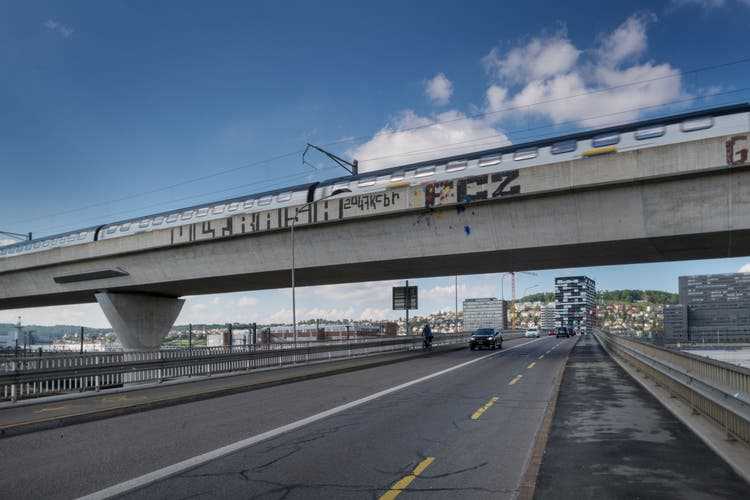
The viaduct of the diameter line, the largest of its kind in Switzerland, runs over the Duttweiler Bridge.
And nowhere else can a very special kind of aesthetics be better observed, which not only railway fans appreciate: the beauty of the train that drives through the city.
An S-Bahn glitters blue and white in the sun as it travels from the Hardbrücke in a long, elegant curve onto the viaduct to Oerlikon. Shiny red, the Intercity chugs to Bern over the railway line of the diameter line, which stretches over the Duttweiler Bridge and only ends up back on the track field in Altstetten. A shunting locomotive drives around small and busy. And the huge track field suddenly looks a bit like the toy Brio train used in the children’s room.
It’s called Europe, but it looks like a piece of the USA.
The Europabrücke pierces dead straight over the river, houses and tracks, from the Höngger Rebberg in the middle of the Altstetter industrial area. Here the cars roar at high speed to the nearby motorway, the bike routes are precarious and the sidewalks are a narrow alibi exercise.
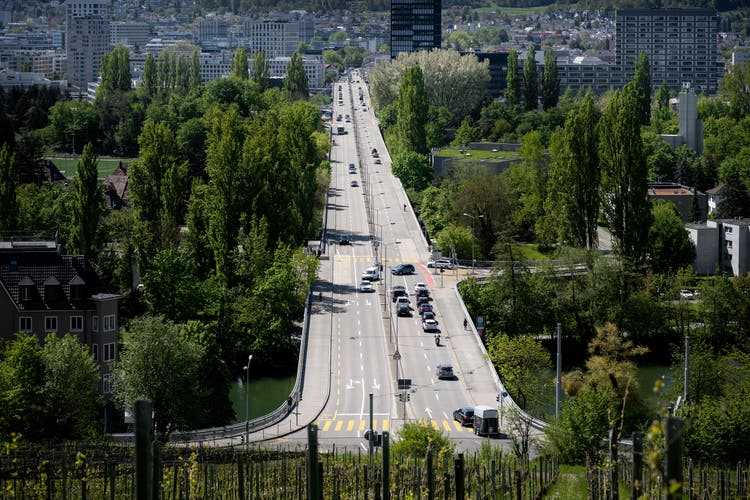
From the Höngger vines to the high-rise buildings of Altstetten: the Europabrücke connects opposites.
Anyone who still dares to drive across it without a car – let’s say early in the morning, just after six, on the way to a report – must be careful. Because suddenly one finds pleasure in this monstrous concrete screed in the outskirts of Zurich. Not because of the sheer impossibility of finding a sensible way over it by bike coming from the Hardturm. And not because of the unfriendly honking of the stressed drivers who don’t always seem to keep to the 50 km/h limit.
No, people like the Europabrücke because of the perspective, the view. Because of the monumental railway landscape below, the chunky skyscrapers above and the expanse of the sky on a clear morning.
Opened to traffic in 1964, this bridge is a remnant of the time when industry, roads, noise and dirt were here. Now it leads from residential area to residential area – a clumsy, functional concrete line in an increasingly curated cityscape.
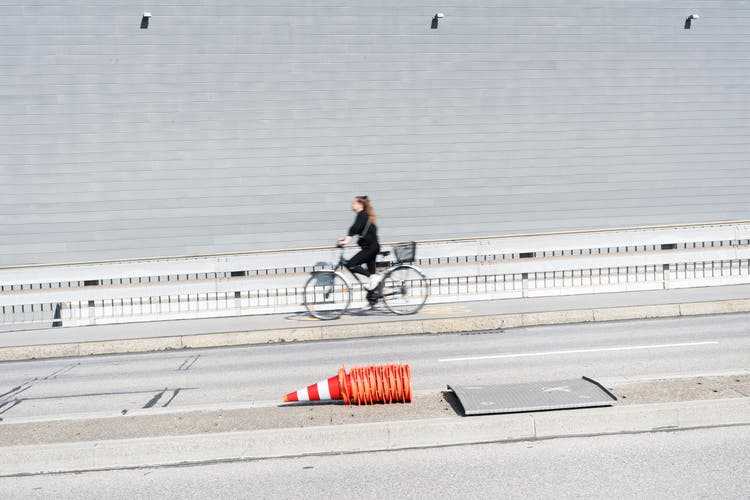
Where cars still set the pace and cyclists have marginal status: the Europa Bridge.
In twenty to thirty years it should be part of this change: A tram should run over the Europabrücke, from Altstetten to Höngg and there through a newly created tunnel to Oerlikon. The cycle lanes are to be expanded, the Europe bridge to become a second hard bridge – a perfectly orchestrated cooperation of all means of transport.
But it’s not that far yet. As a cyclist you can still feel like a cowboy in the Wild Auto West. The route still leads via Europe directly to the USA.
We don’t know they exist until they stop working.
This applies to the large, bulky logistics centers on the outskirts of Zurich, from which a swarm of trucks and small vehicles distribute everything you need to live throughout the city. Letters and parcels, for example, from the futuristic center of Mülligen right on the border to Schlieren.
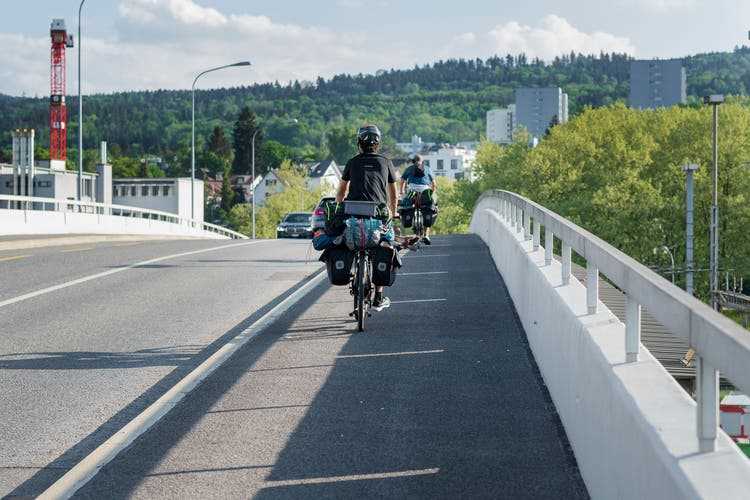
The Agglo Bridge on the outskirts: the sober and useful Hermetschloo Bridge.
But that also applies to the unadorned bridge right next to it, which leads over the tracks to the motorway. Built in 1974, it had to be completely renovated just 22 years later. This prevented not only the Schlieremer and Altstetter the direct way to the allotment gardens separate from the tracks. It also led to the city spending millions more.
Apart from the funny name, the Hermetschloo Bridge is above all sober and useful. It is a freeway feeder. It is the access road for the largest Swiss Post logistics center. It is part of the Zurich city limits. And done.
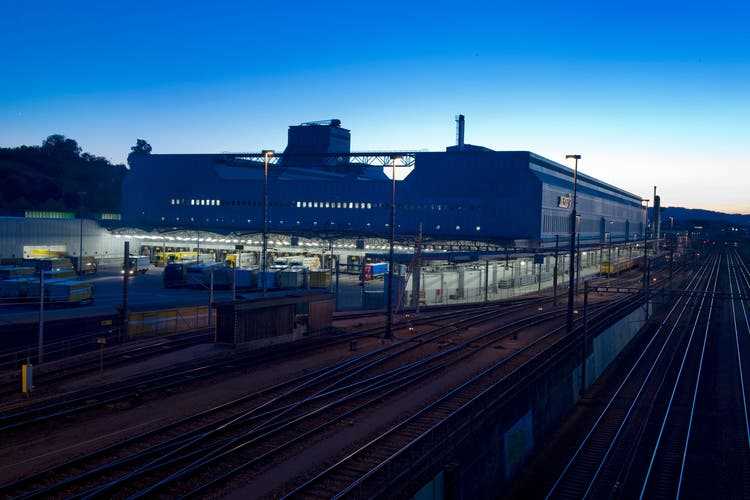
The largest logistics center of Swiss Post: view of the Mülligen letter center from the Hermetschloo Bridge.
Now and then gets lost a train spotter here, sometimes recreational athletes stream over it from the nearby soccer field, or someone sprays a small graffito on it, which promptly displayed at the city will.
Otherwise there are only roaring trains out here, many Post-Töffli and the tram line to the Limmattal that opened a few years ago, which is turning the former no man’s land between Schlieren and Zurich into an increasingly accessible piece of Agglo.
The Hermetschloo is the most typical of Zurich’s railway bridges: a piece of infrastructure that is needed (like the logistics center next to it) but mostly goes unnoticed.
